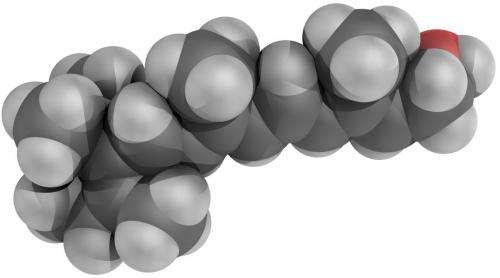Researchers discover new enzyme, link to iron in vitamin A synthesis

A research team's discovery of new information about how plants synthesize carotenoids, precursors for vitamin A that are essential for plant development and survival, and human health, could help scientists increase the levels of provitamin A in food crops and reduce global vitamin A deficiency.
The World Health Organization estimates 250 million children suffer from vitamin A deficiency. Vitamin A deficiency is the leading cause of preventable blindness and increases the risk of disease and death from severe infections. It is a public health problem in more than half of all countries, especially in Africa and Southeast Asia, having a significant impact on young children and pregnant women in low-income countries, according to the World Health Organization.
This global problem has sparked worldwide efforts to increase the levels of provitamin A carotenoids in food crops. To achieve this, scientists must gain further knowledge of how plants control and biosynthesize carotenoids that can be converted to vitamin A in humans.
The findings, published June 15 in Nature Chemical Biology, highlight the team's discovery of a new enzyme that is critical for the biosynthesis of vitamin A in plants and its unexpected dependence on heme iron. This heme iron allows the enzyme to make the necessary structural changes to complete the chemical mechanism for making vitamin A.
Scientists from Georgia State University, City University of New York, New York Structural Biology Center, University of Mississippi Medical Center, University of South Carolina, Georgia Institute of Technology, New Zealand Institute for Plant and Food Research Limited and Albert Einstein College of Medicine collaborated to find out how vitamin A is synthesized in plants.
This study confirmed that 15-cis-ζ-carotene isomerase (Z-ISO) is an enzyme and integral membrane protein. It also found that Z-ISO independently catalyzes the cis-trans isomerization, or chemical reaction that changes the structural conformation of a compound, of the central carbon double bond to produce the required molecule upon which the enzyme acts for the pathway.
"We identified this enzyme plays a significant role in synthesizing vitamin A. This is one critical step to get vitamin A compounds," said Dr. Aimin Liu, Distinguished University Professor of chemistry and biochemistry at Georgia State. "It is really unique in the biosynthetic pathway because it's a relatively large-sized organic molecule. Until recently, it wasn't known which gene product is responsible for these reactions."
Liu and his group used electron paramagnetic resonance (EPR) spectroscopy, which is extremely sensitive to electronic structures, and concluded that Z-ISO is a heme-based protein. Heme is a large, organic system with a metal iron in the center. It is well known because of its red color and presence in red blood cells.
"It's quite surprising to us for a chemical reaction to use heme," Liu said. "It's really new for the chemical field. It's a really large molecule, a very long chain with many double and single bonds. It does not typically allow large molecules to come in. There's not much room to play. We discovered surprisingly that it's an isomerase reaction catalyzed by a heme protein."
EPR spectroscopy revealed the heme center starts as Fe(III) and is reduced to Fe(II), creating room for structural change and a pocket for the Z-ISO enzyme. The heme center rotates the Z-ISO enzyme 180 degrees from the cis orientation, with two groups on the same side, into the thermodynamically favorable trans orientation, which has two groups on opposite sides. The reduction from Fe(III) to Fe(II) is necessary for enzyme activity, Liu said.
"After that, the product can become vitamin A. You still need one to two steps to complete synthesis of vitamin A, but this is the most intriguing step chemically," Liu said.
The findings are significant for those interested in vitamin synthesis, plant biology, plant biochemistry, enzymology and heme proteins, he said.
"It's important to understand this molecular mechanism so in the future we could generate synthetic compounds or modify the forms for different medical purposes," Liu said.
More information: Control of carotenoid biosynthesis through a heme-based cis-trans isomerase, DOI: 10.1038/nchembio.1840
Journal information: Nature Chemical Biology
Provided by Georgia State University

















